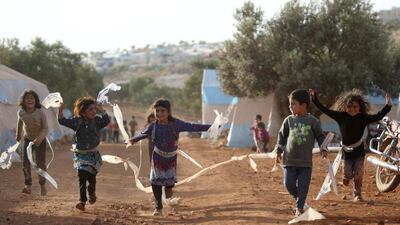The level of peace across the Middle East has improved for the first time in five years, according to a new report issued on Wednesday.
The Global Peace Index, compiled by the Institute for Economics and Peace, a think tank in New York, surveyed 163 countries worldwide to determine their level of peacefulness based on internal and external conflicts , violent crime, homicide rates, political instability and the import and export of weapons.
The report found that the Middle East and North Africa region showed the second-most improvement in peacefulness worldwide, after Russia and the Eurasia region.
This was partly due to Syria losing its tag as the world’s least peaceful country and Iraq showing signs of recovery.
The region experienced a reduction in population displacement, political terror, deaths from internal and external armed conflicts, terrorism, military spending and armed services personnel – all which contributed to the region’s improvement.
"The Middle East has improved marginally in peacefulness," said Steve Killelea, founder and chief chairman of the IEP.
“The main drivers have been a slowing down of the conflict in Syria and there has been fall in number of deaths from internal conflict.
“There is a decrease in the number of refugees and displaced people in the region. The impact of terrorism is also reduced, these factors have combined to create improvement in Middle East and North Africa.”
The most peaceful country in the world, according to the latest edition of the GPI, which measures the performance of countries from March 2018 to March 2019, was Iceland followed closely by New Zealand.
Afghanistan was named as the least peaceful country on the index, with Syria moving up one place after being last in 2018.
The GPI report said the Middle East and North Africa region had a strong finish to the year due the military defeat of ISIL.
The largest deterioration experienced in the region was in Iran, where economic pressures have increased the likelihood of violent demonstrations.
“There are tentative signs of improvement in peacefulness in the Middle East but the bigger picture depends on what happens in the next few years with the potential outbreak of conflict in Iran,” said Mr Killelea.
“There is also the ongoing conflict in Yemen. There is still a high level of conflict there but it is starting to show an improvement in peacefulness through better governance but it’s too early to say if the trend will be repeated in the long-term.”
The index also showed that the gap between the least and most peaceful countries was widening.
“Once countries start falling into the trap of violence it is very easy to keep going down the GPI,” said Mr Killelea.
“Violence perpetuates itself and it is much harder for countries to recover in a post conflict period.
“At the top of the index you have a number of countries which have high levels of positive peace, they have the institutional structures to help maintain peaceful societies.”
The one thing that the countries at the very top of the index all had in common, according to Mr Killelea, were well functioning governments and good business environments, which were easier to maintain once they had initially been established.
The UAE was listed as the 53rd most peaceful country, making the top third of the list. This represented a drop of eight places from last year.


